Literature Review: Nursing Preparedness and Safe Medication Practices
VerifiedAdded on 2023/06/07
|5
|1168
|388
Literature Review
AI Summary
This literature review delves into the critical aspect of nursing preparedness, particularly in medication administration, highlighting the potential risks to patients due to medication errors. It compares a quasi-experimental study by Aggar et al. (2018) that assesses a time management intervention's impact on nursing students' preparedness using simulation, with a study by Hayes et al. (2015) that explores interruptions and errors during medication administration. The review identifies a gap in follow-up assessments and limited scope in existing research, emphasizing the need for strategies to reduce medication administration errors through quality learning and error management techniques. It concludes that with increasing workloads and declining workforces, nurses face challenging situations, necessitating a focus on medication administration and adequate education to ensure patient safety and positive outcomes.
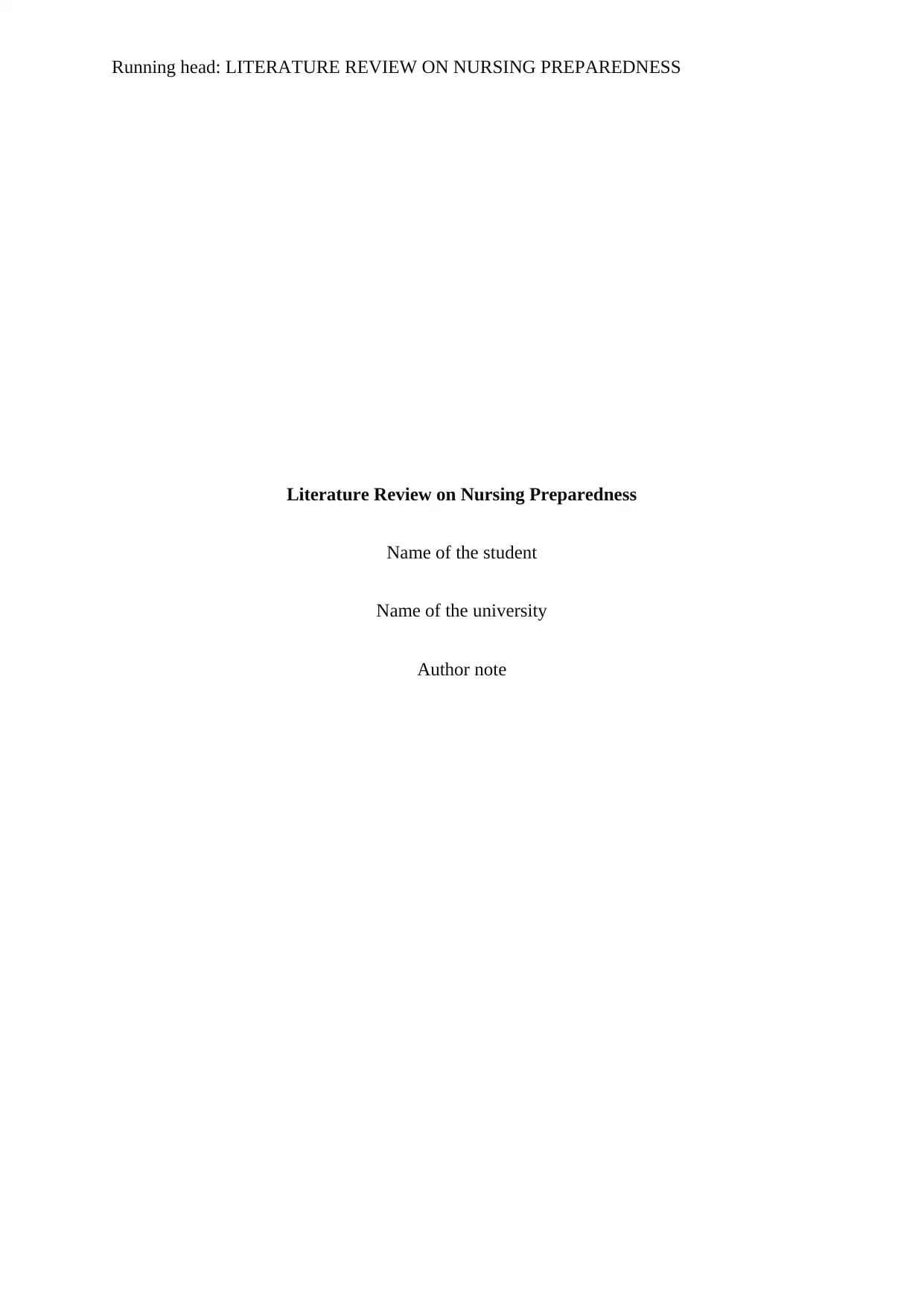
Running head: LITERATURE REVIEW ON NURSING PREPAREDNESS
Literature Review on Nursing Preparedness
Name of the student
Name of the university
Author note
Literature Review on Nursing Preparedness
Name of the student
Name of the university
Author note
Paraphrase This Document
Need a fresh take? Get an instant paraphrase of this document with our AI Paraphraser
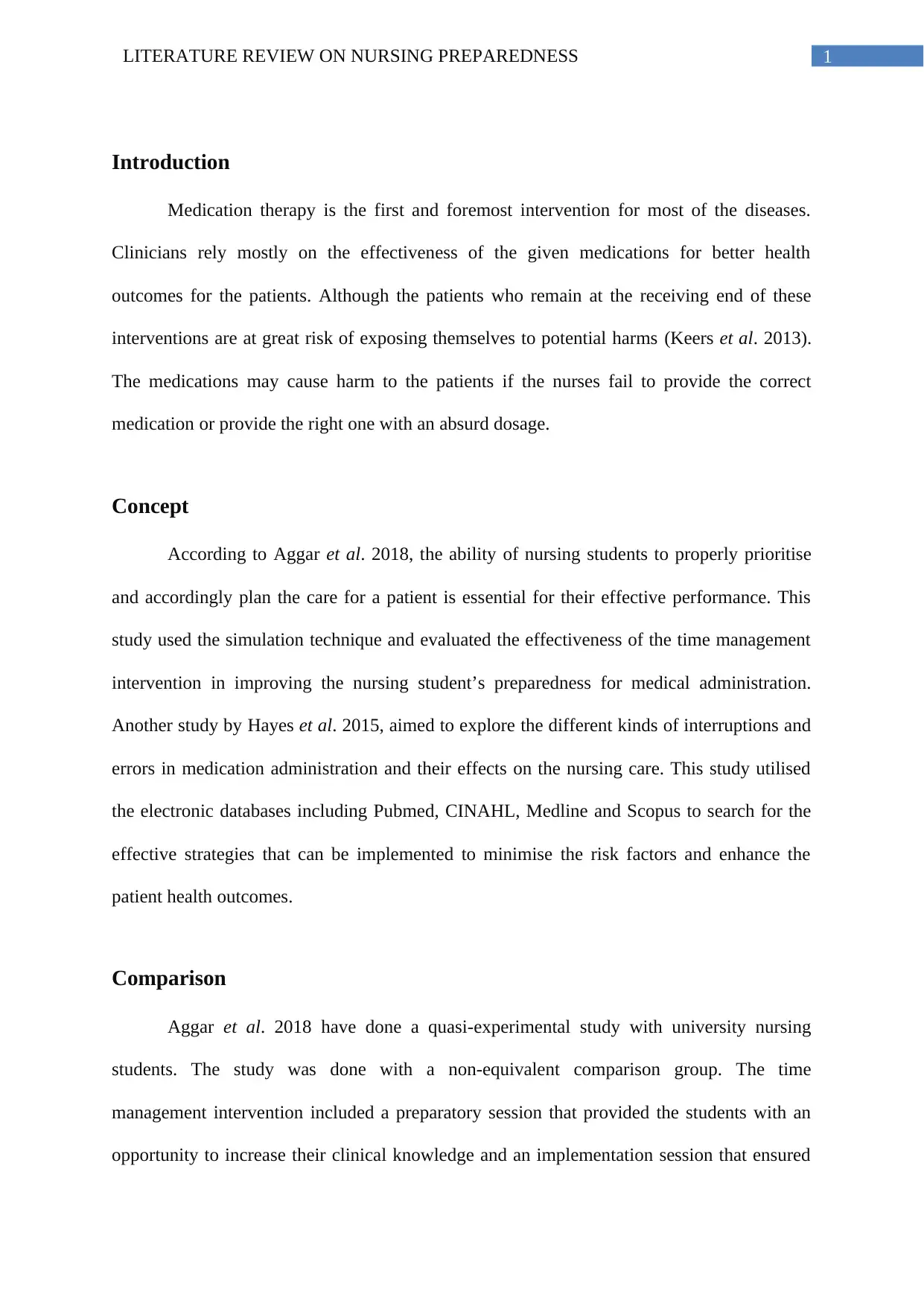
1LITERATURE REVIEW ON NURSING PREPAREDNESS
Introduction
Medication therapy is the first and foremost intervention for most of the diseases.
Clinicians rely mostly on the effectiveness of the given medications for better health
outcomes for the patients. Although the patients who remain at the receiving end of these
interventions are at great risk of exposing themselves to potential harms (Keers et al. 2013).
The medications may cause harm to the patients if the nurses fail to provide the correct
medication or provide the right one with an absurd dosage.
Concept
According to Aggar et al. 2018, the ability of nursing students to properly prioritise
and accordingly plan the care for a patient is essential for their effective performance. This
study used the simulation technique and evaluated the effectiveness of the time management
intervention in improving the nursing student’s preparedness for medical administration.
Another study by Hayes et al. 2015, aimed to explore the different kinds of interruptions and
errors in medication administration and their effects on the nursing care. This study utilised
the electronic databases including Pubmed, CINAHL, Medline and Scopus to search for the
effective strategies that can be implemented to minimise the risk factors and enhance the
patient health outcomes.
Comparison
Aggar et al. 2018 have done a quasi-experimental study with university nursing
students. The study was done with a non-equivalent comparison group. The time
management intervention included a preparatory session that provided the students with an
opportunity to increase their clinical knowledge and an implementation session that ensured
Introduction
Medication therapy is the first and foremost intervention for most of the diseases.
Clinicians rely mostly on the effectiveness of the given medications for better health
outcomes for the patients. Although the patients who remain at the receiving end of these
interventions are at great risk of exposing themselves to potential harms (Keers et al. 2013).
The medications may cause harm to the patients if the nurses fail to provide the correct
medication or provide the right one with an absurd dosage.
Concept
According to Aggar et al. 2018, the ability of nursing students to properly prioritise
and accordingly plan the care for a patient is essential for their effective performance. This
study used the simulation technique and evaluated the effectiveness of the time management
intervention in improving the nursing student’s preparedness for medical administration.
Another study by Hayes et al. 2015, aimed to explore the different kinds of interruptions and
errors in medication administration and their effects on the nursing care. This study utilised
the electronic databases including Pubmed, CINAHL, Medline and Scopus to search for the
effective strategies that can be implemented to minimise the risk factors and enhance the
patient health outcomes.
Comparison
Aggar et al. 2018 have done a quasi-experimental study with university nursing
students. The study was done with a non-equivalent comparison group. The time
management intervention included a preparatory session that provided the students with an
opportunity to increase their clinical knowledge and an implementation session that ensured
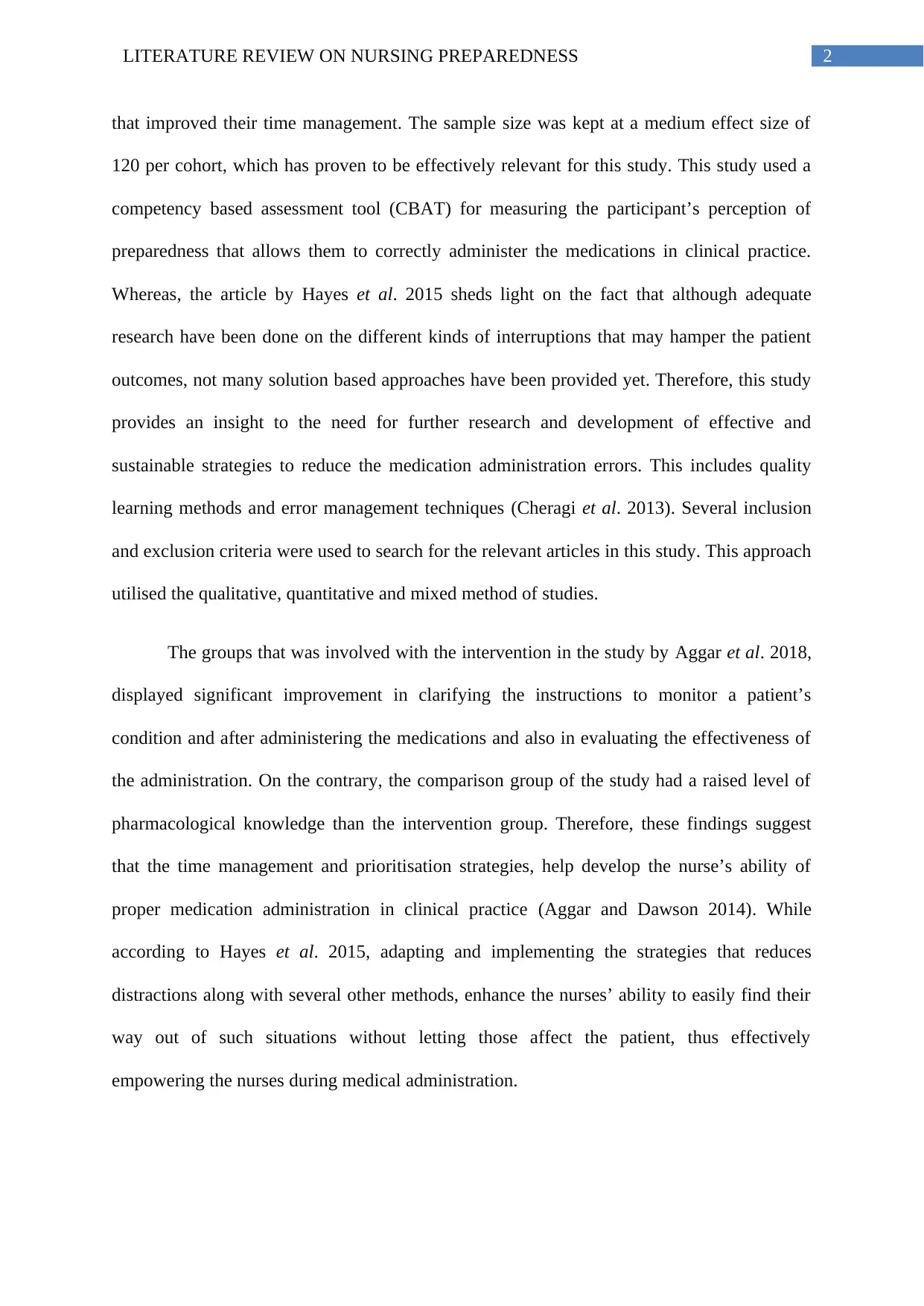
2LITERATURE REVIEW ON NURSING PREPAREDNESS
that improved their time management. The sample size was kept at a medium effect size of
120 per cohort, which has proven to be effectively relevant for this study. This study used a
competency based assessment tool (CBAT) for measuring the participant’s perception of
preparedness that allows them to correctly administer the medications in clinical practice.
Whereas, the article by Hayes et al. 2015 sheds light on the fact that although adequate
research have been done on the different kinds of interruptions that may hamper the patient
outcomes, not many solution based approaches have been provided yet. Therefore, this study
provides an insight to the need for further research and development of effective and
sustainable strategies to reduce the medication administration errors. This includes quality
learning methods and error management techniques (Cheragi et al. 2013). Several inclusion
and exclusion criteria were used to search for the relevant articles in this study. This approach
utilised the qualitative, quantitative and mixed method of studies.
The groups that was involved with the intervention in the study by Aggar et al. 2018,
displayed significant improvement in clarifying the instructions to monitor a patient’s
condition and after administering the medications and also in evaluating the effectiveness of
the administration. On the contrary, the comparison group of the study had a raised level of
pharmacological knowledge than the intervention group. Therefore, these findings suggest
that the time management and prioritisation strategies, help develop the nurse’s ability of
proper medication administration in clinical practice (Aggar and Dawson 2014). While
according to Hayes et al. 2015, adapting and implementing the strategies that reduces
distractions along with several other methods, enhance the nurses’ ability to easily find their
way out of such situations without letting those affect the patient, thus effectively
empowering the nurses during medical administration.
that improved their time management. The sample size was kept at a medium effect size of
120 per cohort, which has proven to be effectively relevant for this study. This study used a
competency based assessment tool (CBAT) for measuring the participant’s perception of
preparedness that allows them to correctly administer the medications in clinical practice.
Whereas, the article by Hayes et al. 2015 sheds light on the fact that although adequate
research have been done on the different kinds of interruptions that may hamper the patient
outcomes, not many solution based approaches have been provided yet. Therefore, this study
provides an insight to the need for further research and development of effective and
sustainable strategies to reduce the medication administration errors. This includes quality
learning methods and error management techniques (Cheragi et al. 2013). Several inclusion
and exclusion criteria were used to search for the relevant articles in this study. This approach
utilised the qualitative, quantitative and mixed method of studies.
The groups that was involved with the intervention in the study by Aggar et al. 2018,
displayed significant improvement in clarifying the instructions to monitor a patient’s
condition and after administering the medications and also in evaluating the effectiveness of
the administration. On the contrary, the comparison group of the study had a raised level of
pharmacological knowledge than the intervention group. Therefore, these findings suggest
that the time management and prioritisation strategies, help develop the nurse’s ability of
proper medication administration in clinical practice (Aggar and Dawson 2014). While
according to Hayes et al. 2015, adapting and implementing the strategies that reduces
distractions along with several other methods, enhance the nurses’ ability to easily find their
way out of such situations without letting those affect the patient, thus effectively
empowering the nurses during medical administration.
⊘ This is a preview!⊘
Do you want full access?
Subscribe today to unlock all pages.

Trusted by 1+ million students worldwide
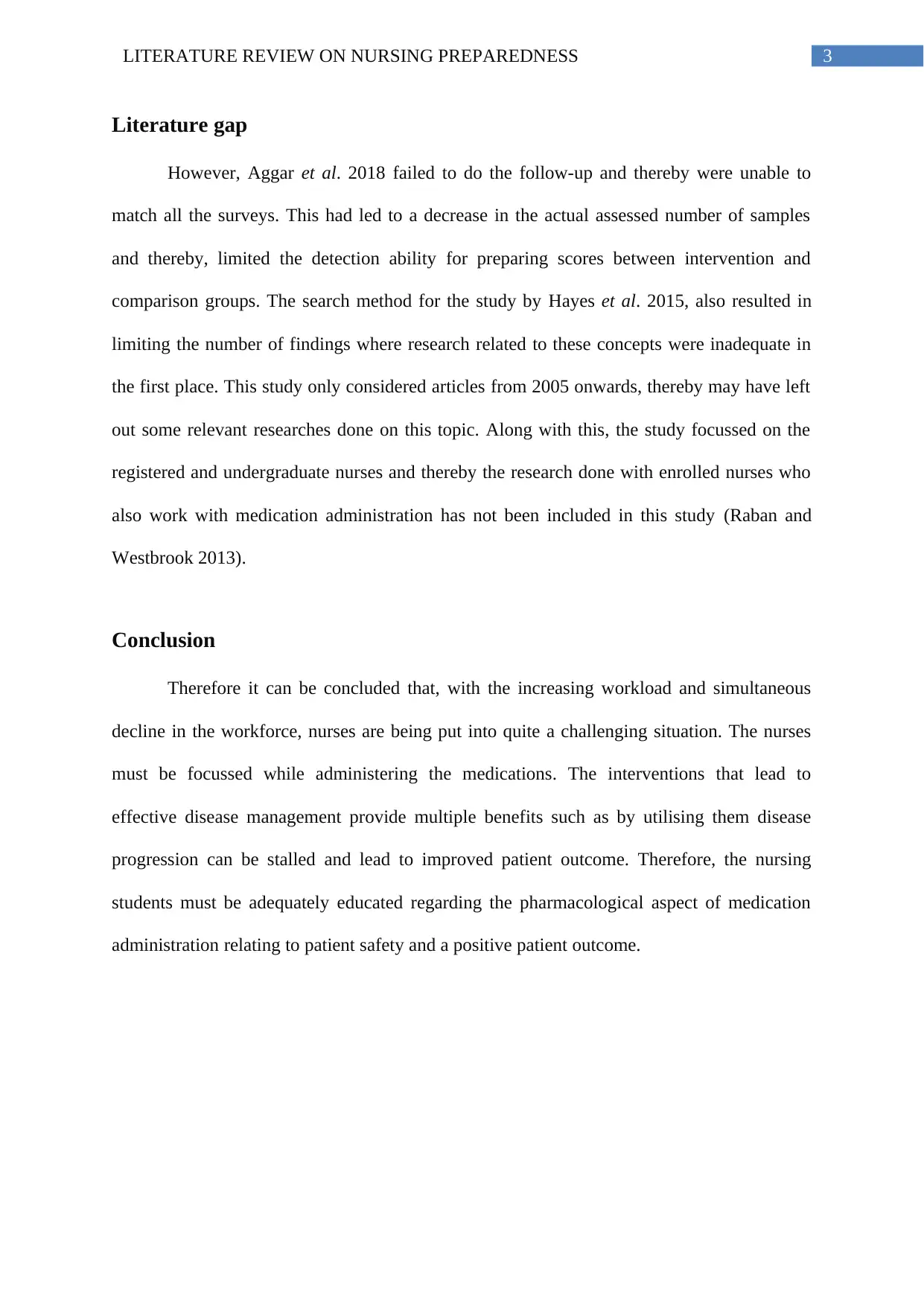
3LITERATURE REVIEW ON NURSING PREPAREDNESS
Literature gap
However, Aggar et al. 2018 failed to do the follow-up and thereby were unable to
match all the surveys. This had led to a decrease in the actual assessed number of samples
and thereby, limited the detection ability for preparing scores between intervention and
comparison groups. The search method for the study by Hayes et al. 2015, also resulted in
limiting the number of findings where research related to these concepts were inadequate in
the first place. This study only considered articles from 2005 onwards, thereby may have left
out some relevant researches done on this topic. Along with this, the study focussed on the
registered and undergraduate nurses and thereby the research done with enrolled nurses who
also work with medication administration has not been included in this study (Raban and
Westbrook 2013).
Conclusion
Therefore it can be concluded that, with the increasing workload and simultaneous
decline in the workforce, nurses are being put into quite a challenging situation. The nurses
must be focussed while administering the medications. The interventions that lead to
effective disease management provide multiple benefits such as by utilising them disease
progression can be stalled and lead to improved patient outcome. Therefore, the nursing
students must be adequately educated regarding the pharmacological aspect of medication
administration relating to patient safety and a positive patient outcome.
Literature gap
However, Aggar et al. 2018 failed to do the follow-up and thereby were unable to
match all the surveys. This had led to a decrease in the actual assessed number of samples
and thereby, limited the detection ability for preparing scores between intervention and
comparison groups. The search method for the study by Hayes et al. 2015, also resulted in
limiting the number of findings where research related to these concepts were inadequate in
the first place. This study only considered articles from 2005 onwards, thereby may have left
out some relevant researches done on this topic. Along with this, the study focussed on the
registered and undergraduate nurses and thereby the research done with enrolled nurses who
also work with medication administration has not been included in this study (Raban and
Westbrook 2013).
Conclusion
Therefore it can be concluded that, with the increasing workload and simultaneous
decline in the workforce, nurses are being put into quite a challenging situation. The nurses
must be focussed while administering the medications. The interventions that lead to
effective disease management provide multiple benefits such as by utilising them disease
progression can be stalled and lead to improved patient outcome. Therefore, the nursing
students must be adequately educated regarding the pharmacological aspect of medication
administration relating to patient safety and a positive patient outcome.
Paraphrase This Document
Need a fresh take? Get an instant paraphrase of this document with our AI Paraphraser
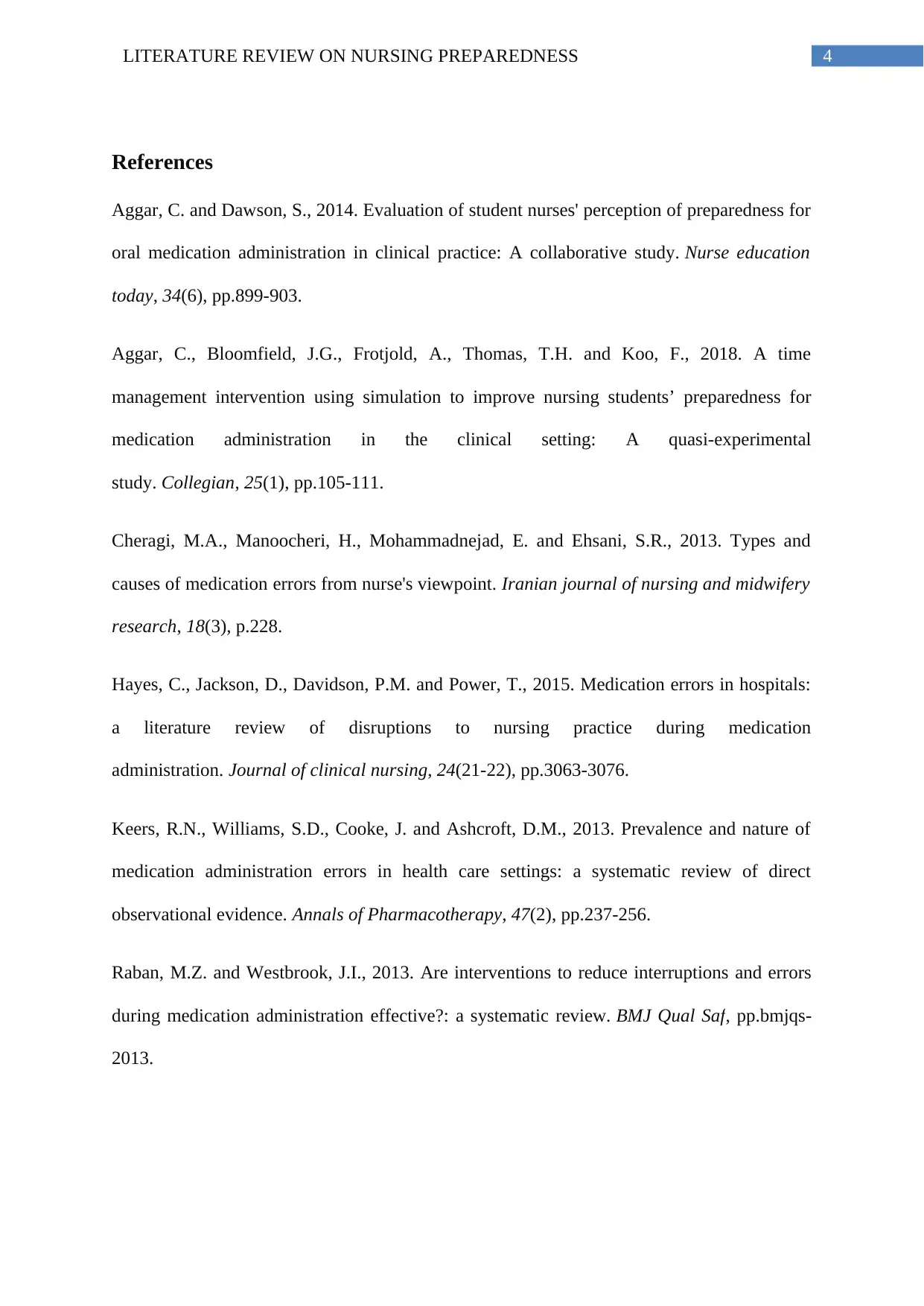
4LITERATURE REVIEW ON NURSING PREPAREDNESS
References
Aggar, C. and Dawson, S., 2014. Evaluation of student nurses' perception of preparedness for
oral medication administration in clinical practice: A collaborative study. Nurse education
today, 34(6), pp.899-903.
Aggar, C., Bloomfield, J.G., Frotjold, A., Thomas, T.H. and Koo, F., 2018. A time
management intervention using simulation to improve nursing students’ preparedness for
medication administration in the clinical setting: A quasi-experimental
study. Collegian, 25(1), pp.105-111.
Cheragi, M.A., Manoocheri, H., Mohammadnejad, E. and Ehsani, S.R., 2013. Types and
causes of medication errors from nurse's viewpoint. Iranian journal of nursing and midwifery
research, 18(3), p.228.
Hayes, C., Jackson, D., Davidson, P.M. and Power, T., 2015. Medication errors in hospitals:
a literature review of disruptions to nursing practice during medication
administration. Journal of clinical nursing, 24(21-22), pp.3063-3076.
Keers, R.N., Williams, S.D., Cooke, J. and Ashcroft, D.M., 2013. Prevalence and nature of
medication administration errors in health care settings: a systematic review of direct
observational evidence. Annals of Pharmacotherapy, 47(2), pp.237-256.
Raban, M.Z. and Westbrook, J.I., 2013. Are interventions to reduce interruptions and errors
during medication administration effective?: a systematic review. BMJ Qual Saf, pp.bmjqs-
2013.
References
Aggar, C. and Dawson, S., 2014. Evaluation of student nurses' perception of preparedness for
oral medication administration in clinical practice: A collaborative study. Nurse education
today, 34(6), pp.899-903.
Aggar, C., Bloomfield, J.G., Frotjold, A., Thomas, T.H. and Koo, F., 2018. A time
management intervention using simulation to improve nursing students’ preparedness for
medication administration in the clinical setting: A quasi-experimental
study. Collegian, 25(1), pp.105-111.
Cheragi, M.A., Manoocheri, H., Mohammadnejad, E. and Ehsani, S.R., 2013. Types and
causes of medication errors from nurse's viewpoint. Iranian journal of nursing and midwifery
research, 18(3), p.228.
Hayes, C., Jackson, D., Davidson, P.M. and Power, T., 2015. Medication errors in hospitals:
a literature review of disruptions to nursing practice during medication
administration. Journal of clinical nursing, 24(21-22), pp.3063-3076.
Keers, R.N., Williams, S.D., Cooke, J. and Ashcroft, D.M., 2013. Prevalence and nature of
medication administration errors in health care settings: a systematic review of direct
observational evidence. Annals of Pharmacotherapy, 47(2), pp.237-256.
Raban, M.Z. and Westbrook, J.I., 2013. Are interventions to reduce interruptions and errors
during medication administration effective?: a systematic review. BMJ Qual Saf, pp.bmjqs-
2013.
1 out of 5
Related Documents
Your All-in-One AI-Powered Toolkit for Academic Success.
+13062052269
info@desklib.com
Available 24*7 on WhatsApp / Email
![[object Object]](/_next/static/media/star-bottom.7253800d.svg)
Unlock your academic potential
Copyright © 2020–2025 A2Z Services. All Rights Reserved. Developed and managed by ZUCOL.





